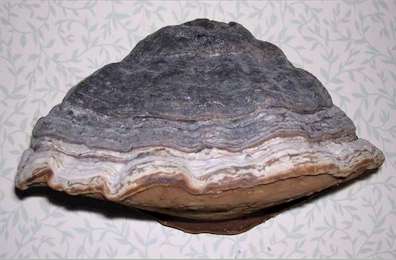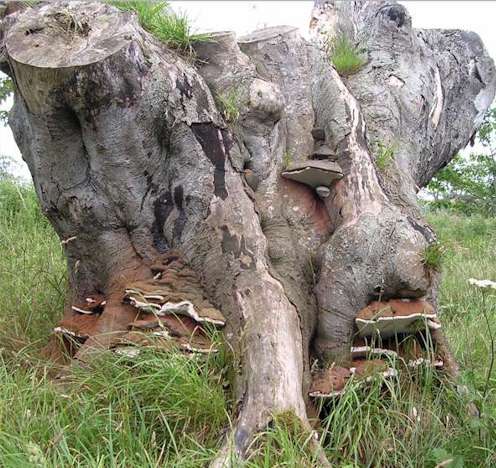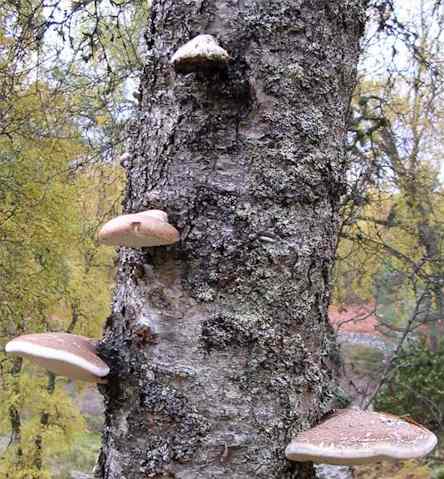..
THE POLYPORE BRACKET FUNGI Many of the wood-rotting fungi that grow on trees produce large, perennial, bracket-shaped fruitbodies and release their basidiospores through small pores on the underside. One of the classic examples is Fomes fomentarius, a fungus found commonly on birch trees (Betula spp.) in Scotland and commonly known as the "Hoof fungus" (Fig. 1). It is an important white-rot fungus (so-called because the rotting wood remains white as it decays (see Chapter XX). The fruitbodies are usually 20 to 30 cm across and are very hard (woody). Their annual zones of growth are clearly seen in the images below. Because these fruitbodies are rigidly supported where they grow out of the tree, the pores on their undersides can be extremely small (4 or 5 pores per millimetre) and still enable the spores to fall vertically within the pores for release into the environment.
Fig 1. A basidiocarp of the hoof fungus, Fomes fomentarius, showing at least 7 annual zones of growth. A new, younger white-coloured zone is formed each year. [© Jim Deacon]
Figs 2, 3. Further examples of F. fomentarius in nature (left) and dried and mounted on the author's wall (right). [© Jim Deacon]
Fig 4. A massive stump of an old beech tree (Fagus sylvaticus) bearing many fruitbodies of the woody bracket fungus Ganoderma adspersum (a white-rot fungus). This stump had at least 37 clustered tiers of fruitbodies, some of the individual fruitbodies being up to 50 cm across. Note the large number of brown basidiospores deposited on the tree surface, and the newest, white annual zones of growth of the perennial brackets. [© Jim Deacon] In contrast to the perennial brackets of Fomes and Ganoderma, the birch polypore (Piptoporus betulinus) is a host-specialised invader of birch trees (Betula spp.) in which it causes an intense white rot. The young brackets are dome-shaped with a rounded white margin (Fig. 5) and they have a rubbery consistency. They can be used to sharpen razors, so this fungus is also known as the Razor-strop fungus. The brackets expand progressively in the first growing season, up to about 15 cm wide, and persist through the winter but then they decay and may be replaced by further annual fruitbodies in subsequent seasons. Several brackets are often seen on a single tree (Figs 5, 6). In their mature phase the fruitbodies have white pores and a smooth, light brown coloured cap.
Fig 5 A young basidiocarp of Piptoporus betulinus, with a light-grey-coloured cap. [© Jim Deacon]
Fig 6. Several fruitbodies of Piptoporus betulinus in different stages of development (or senescence) on the trunk of a standing, dead birch tree. [© Jim Deacon] |





